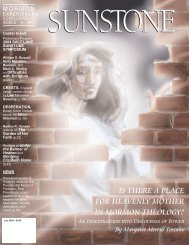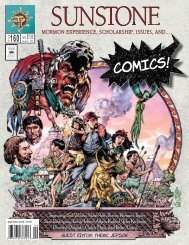00a_cover cmyk dark blue.qxp - Sunstone Magazine
00a_cover cmyk dark blue.qxp - Sunstone Magazine
00a_cover cmyk dark blue.qxp - Sunstone Magazine
Create successful ePaper yourself
Turn your PDF publications into a flip-book with our unique Google optimized e-Paper software.
S U N S T O N E<br />
lined a philosophy of religion and science he<br />
called NOMA, or “non-overlapping magisteria,”<br />
wherein the two realms of science and<br />
religion are encouraged to maintain a respectful,<br />
strict separation. “NOMA seeks no<br />
false fusion,” he explains, “but urges two distinct<br />
sides to stay on their own turf” and to<br />
“develop their best solutions to designated<br />
parts of life’s totality.” 5 In other words, faith<br />
and knowledge must remain entirely separate;<br />
any attempt at reconciliation invites disaster.<br />
But Mormon literature demonstrates an alternate<br />
approach. With near consensus, LDS<br />
authors express something that might be<br />
called GOMA, or gradually overlapping magisteria.<br />
They seem to share a sentiment that<br />
while knowledge and faith may presently be<br />
at odds, once both are fully understood,<br />
they’ll harmonize perfectly. Richard P. Smith<br />
puts it best: “Since Mormonism and science<br />
are both basically true, they will converge<br />
eventually.” 6<br />
This belief does not imply that we should<br />
expect, or even want, any overlap today. It remains<br />
inappropriate, for example, for the<br />
Church to make an official doctrinal stand on<br />
evolution or geology. Duane Jeffrey writes:<br />
Authoritative statements concerning<br />
scientific matters seem neither<br />
necessary nor desirable, even if<br />
the knowledge to make them did<br />
exist, and it seems clear that it does<br />
not. Effective arguments can be<br />
marshaled to support the point that<br />
such pronouncements, necessarily<br />
restrictive in their nature, would<br />
stifle the very experience that life is<br />
supposed to provide; they would be<br />
inimical to the very roots of the<br />
process of “evolving into a God.” 7<br />
Nor, in fact, should we be too concerned<br />
about what Church leaders believe about the<br />
age of the earth, the mutability of species, or<br />
the details of the Creation. Eyring explains, “I<br />
never worry what the Brethren believe about<br />
my specialty today because it is part of the genius<br />
of the Lord’s Church that both they and I<br />
will understand the entire situation better tomorrow.”<br />
8<br />
ATHIRD prominent theme in the literature<br />
is a concern for the Church’s<br />
change in its general attitude toward<br />
science since the wave of anti-science sentiment<br />
led by Joseph Fielding Smith, Bruce R.<br />
McConkie, and Mark E. Peterson. Richard P.<br />
Smith asks:<br />
When will I again see General<br />
Authorities, Church publications,<br />
teachers, and parents give assurance<br />
to all that science blends<br />
beautifully with Mormonism? Yes,<br />
Virginia, that’s the way it was in the<br />
thirties when I was a child in<br />
northern Utah, and on into the<br />
early fifties. That sort of support for<br />
science is unknown to today’s<br />
young Mormons; instead they hear<br />
that much of what the schools<br />
teach is wrong and they had better<br />
not believe it. I’m thankful that my<br />
faith wasn’t subjected to that test<br />
and that I had help with my concerns<br />
about whether a scientist<br />
could be a Latter-day Saint. Are not<br />
today’s students and scientists in<br />
greater jeopardy of failing to develop<br />
strong faith in the Church? 9<br />
David Bailey echoes this concern and<br />
worries that we have replaced the pro-science<br />
doctrines of the early restoration with<br />
anti-science sentiment borrowed from traditional<br />
Christianity:<br />
Latter-day Saint theology, with its<br />
rich tradition of naturalism and<br />
open-minded attitudes toward science,<br />
is to many intellectually<br />
minded members a major factor in<br />
their continued faith. There is no<br />
question that its foundation of natural<br />
law and rationality permits a<br />
significantly cleaner accommodation<br />
of the principles of science than<br />
most other theological systems.<br />
However, this tradition may be<br />
in danger as the Church continues<br />
to experience exponential growth,<br />
bringing in converts whose beliefs<br />
are deeply rooted in the theologies<br />
of traditional Christianity. Current<br />
Church literature frequently includes<br />
statements about God’s absolute<br />
omnipotence and his ability<br />
to alter the laws of nature, even<br />
though these sectarian doctrines<br />
sharply disagree with traditional<br />
Mormon theology. Similarly, the<br />
conservatism that pervades modern<br />
creation beliefs in the Church<br />
seems to have more in common<br />
with certain Christian fundamentalist<br />
sects than with the openminded<br />
philosophies of the early<br />
Church leaders. 10<br />
OUTSIDE of these important themes,<br />
there have been numerous treatments<br />
of more specific matters: cosmology,<br />
evolution, psychology, and more.<br />
But in nearly all cases, even very specific<br />
topics are still related to or build upon the<br />
three themes I’ve listed here. And they are<br />
themes that will probably influence most future<br />
contributions as well.<br />
It is exhilarating and daunting to begin a<br />
new column dedicated to the intersection of<br />
Mormonism with science and health. But<br />
dis<strong>cover</strong>ing just how large and solid the<br />
foundation is, I’m all the more excited to start<br />
building. I invite your contributions to this<br />
important endeavor.<br />
NOTES<br />
1. Edward L. Kimball, “A Dialogue with Henry<br />
Eyring,” Dialogue: A Journal of Mormon Thought 8, nos.<br />
3/4 (Autumn/Winter 1973): 104.<br />
2. Clyde Parker and Brent Miller, “Dialogues on<br />
Science and Religion,” Dialogue 8, nos. 3/4<br />
(Autumn/Winter 1973): 117.<br />
3. Robert C. Fletcher, “One Scientist’s Spiritual<br />
Autobiography,” SUNSTONE, September 1985, 35.<br />
4. John A. Widtsoe, Joseph Smith as Scientist: A<br />
Contribution to Mormon Philosophy (Salt Lake City:<br />
Bookcraft, 1964), 1.<br />
5. Stephen J. Gould, Rocks of Ages: Science and<br />
Religion in the Fullness of Life (New York: Ballantine,<br />
1999), 211.<br />
6. Richard P. Smith, “Science: A Part of or Apart<br />
from Mormonism?,” Dialogue 19, no. 1 (Spring<br />
1986), 118.<br />
7. Duane E. Jeffery, “Seers, Savants and<br />
Evolution: The Uncomfortable Interface,” Dialogue<br />
34, nos. 1/2 (Spring/Summer 2001), 222<br />
8. Quoted in Smith, “Science, A Part of or Apart<br />
from Mormonism?,” 13.<br />
9. Ibid, 106.<br />
10. David H. Bailey, “Scientific Foundations of<br />
Mormon Theology,” Dialogue 21, no. 2 (Summer<br />
1988), 78.<br />
JOEL KAUFFMANN<br />
SEPTEMBER 2006 PAGE 59

















